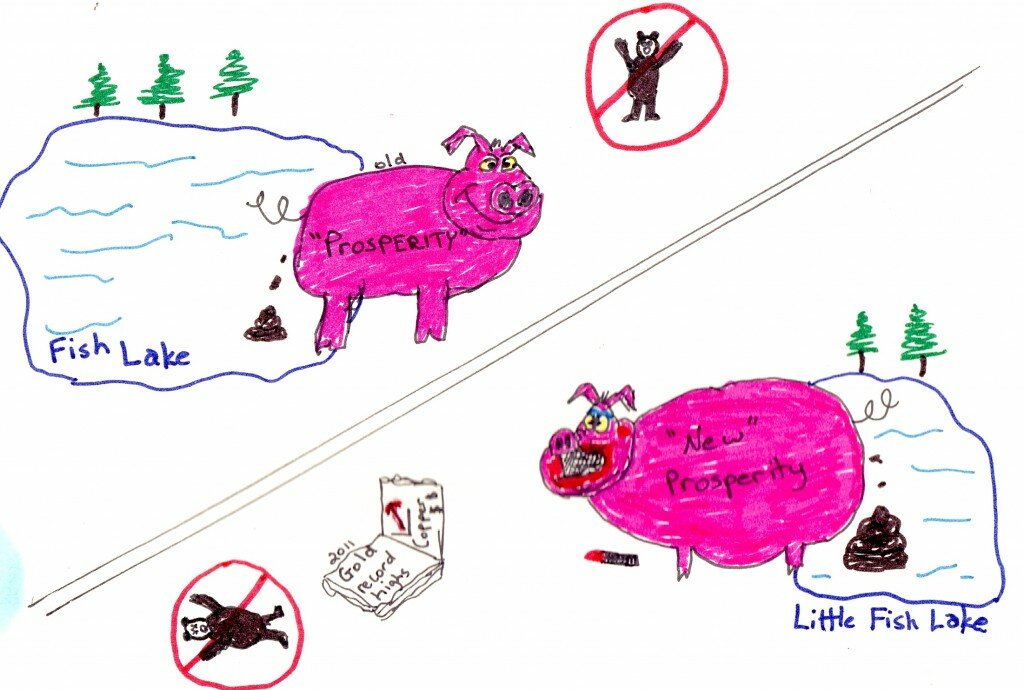
inspired by good 'ol Far Side
.
If this isn’t worrisome to Canadian sovereignty, aboriginal rights & title, and unsettled BC treaties… well… maybe we might as well shed the maple leaf and the white parts of the flag, and scuttle the BC Treaty Process (maybe a self-fulfilling prophecy), and why bother with any court cases about aboriginal rights and title…?
Some headlines from today and yesterday:
CALGARY — Chinese investment in Canada’s energy sector could move to a new level if wins a bid to build the controversial .
The largest of China’s three state-controlled oil companies has expressed an interest in building the $5.5-billion project across the northern Canadian Rockies and is considering purchasing an equity stake, said Pat Daniel, president and CEO of proponent
“They have made the point to us that they are very qualified in building pipelines, and we will take that into consideration when we are looking for contractors,” Mr. Daniel said in an interview. “It’s an open bid process. They are a very big organization, they build a lot of pipelines, and they would love to be involved from what they have told me.”
…
_ _ _ _ _ _ _ _
NEW YORK — A big shift is happening in Big Oil: an American giant now ranks behind a Chinese upstart.
Exxon Mobil is no longer the world’s biggest publicly traded producer of oil. For the first time, that distinction belongs to a 13-year-old Chinese company called PetroChina. The Beijing company was created by the Chinese government to secure more oil for that nation’s booming economy.
_ _ _ _ _ _ _ _
CALGARY – Oil traders still grappling with an unprecedented pipeline bottleneck in the U.S. Midwest that roiled global energy markets last year should beware: Canada may be next.
The pipelines that carry crude from Alberta’s oil sands and the Bakken shale fields of North Dakota to U.S. refiners may run out of capacity as soon as 2015, some analysts now warn.
Fears that the export of Canadian crude will be constrained have risen recently as a result of pipeline project delays and the unyielding growth of North Dakota output. Any resulting glut could weaken Canadian oil prices, depress profits for producers like Suncor Energy Inc and Cenovus Energy Inc and choke growth in the largest source of U.S. imports.
A crisis could be avoided, though. Major pipeline operators like Enbridge Inc say they’re confident that an estimated 1 million barrels per day (bpd) of idle capacity on existing Canada-to-U.S. lines is more than enough for up to five years, sufficient time to complete new lines or add pumps.
That view is by no means unanimous.
…
The government is also taking action. Canada is set to push forward new measures to cut approval times for major pipeline projects in order to speed the completion of proposed routes to the Pacific Ocean and refiners in Asia.
“At a certain point there will be an issue (with capacity),” Joe Oliver, Canada’s natural resources minister, said in an interview this week. “We remain optimistic that pipelines can be built in time to avoid … the kind of problem they have in Cushing.”
_ _ _ _ _ _ _ _ _
The federal government gave a boost to oil sands exports to Asia by streamlining the environmental review process and making it more difficult for environmental groups to mount an opposition.
[ummm… yeah… it doesn’t seem to just be “environmental groups mounting opposition… there’s this finnicky thing called: ‘average Canadians’… that are in opposition]
In its budget brought down Thursday, Ottawa said it will propose legislation aimed at having “one project, one review” that establishes clear timelines for approval of big resource and industrial projects, reduces duplication and regulatory burdens, and focuses resources on the largest projects with the biggest environmental impacts.
Most of Canada’s oil is now exported to the United States, where it is heavily discounted because of pipeline bottlenecks.
Canadian governments and industry have been pushing for market diversification in Asia by way of new pipelines to the West Coast, but have run into opposition from the environmental movement and First Nations that are targeting regulatory reviews to delay the projects…
…
_ _ _ _ _ _ _ _ _
If Enbridge gets turned down in the current process surrounding the Northern Exit-way pipeline then folks in B.C. better be ready for an onslaught of pipeline proposals, that will be guided by the new Harper “one project, one review” process.
And PetroChina, now bigger than Exxon (which carried the title of world’s biggest money-maker until Apple recently unseeded it) will not take “NO” for an answer.
Especially when the tar sands oil in Alberta essentially becomes theirs… through straight up buying up whatever they want. There’s already some $20 billion or so (on the low end) invested by PetroChina and other Chinese firms in Alberta’s tar sands operations.
When the world’s biggest oil company, which is trying to feed an insatiable beast…
well, Houston… and B.C. … we have a problem.




